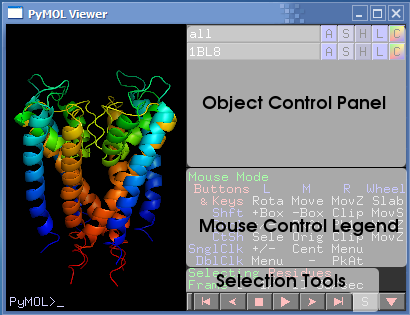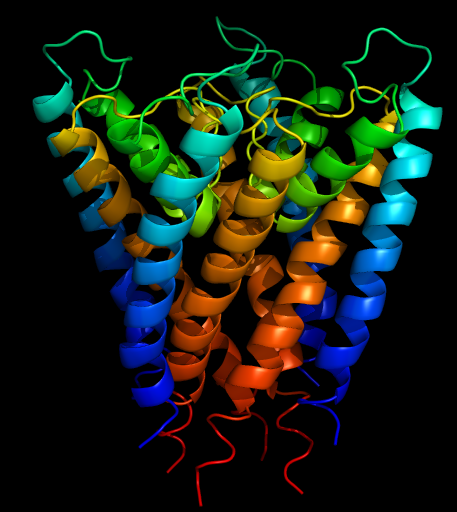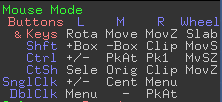This is a read-only mirror of pymolwiki.org
Practical Pymol for Beginners
Although PyMol has a powerful and flexible interface, it is complex, and can appear daunting to new users. This guide is intended to introduce the PyMol interface and basic tasks without leaving the mouse behind.
The PyMol Interface
When PyMol is opened, two windows appear. The smaller window (called the "External GUI" in PyMol documentation) has the menu bar (File, Edit, Help, Display, etc), a set of buttons which are shortcuts to common commands, and the command line.
The second window is the PyMOL Viewer, which is where all the magic happens. In the Viewer, 3D models are displayed, and the user interacts (eg rotates) and manipulates the model.
The objects that PyMOL renders in 3D are loaded from coordinate files that describe (in great detail) locations of individual atoms in the molecule. PyMOL can display more than one object at a time, and provides an Object Control Panel to adjust viewing modes, colors, labels, hiding, and just about anything else relating to objects. After each object name is a set of command buttons which control the object. Here are the buttons and some of their options:
- A - Actions: Rename, duplicate, remove, apply presets (like "ball-and-stick" or "publication"), perform computations
- S - Show: Change the way things appear, eg change to stick or cartoon view.
- H - Hide: Things that are shown using S accumulate, and don't automatically replace the last view. H is the opposite of S and hides unwanted representations.
- L - Label: Label atoms, residues, etc.
- C - Color: Change the color of atoms and groups.
The lower-right corner of the Viewer contains a guide to using the mouse, as well as a powerful selection tool. There is also another command line at the bottom of the Viewer (PyMOL>).
About the command line
The PyMol command line is a great tool that lets the experienced user change all sorts of options that simply don't appear in the point-and-click graphical interface. It can also be a lot faster. Combined with scripting, it is a powerful option for automating tasks and making intricate sets of changes. But, it's complex, and page upon page of PyMol documentation cover these commands, so we're going to ignore them as much as possible.
Although this guide may include some text commands (like this), they're purely optional and meant to be informative. To run any text command, type it in at a PyMOL> command line and hit [Enter].
Getting started: explore a protein
PyMol is great for casual visualization of biological molecules. In this example, a PDB file describing a protein is loaded and its style and color are tweaked.
- Obtain a PDB coordinates file for your favorite protein. (The RCSB Protein Data Bank is a public structure repository containing over 40,000 protein structures in PDB format available for download, not a bad place to look.) For this example, we're using the potassium channel from Streptomyces Lividans (1BL8).
- Open the PDB file using File, Open... from the menu bar. The protein's structure will appear, probably rendered as simple bonding lines.
- The right side of the Viewer shows the loaded PDB as an object, as well as its command buttons. Each button contains a submenu with more options. Click S, then cartoon to show the protein's secondary structure in popular cartoon form.
- Notice that the lines view is still visible on top of the cartoon view. To hide the lines, click H then lines.
- To change the color of each protein chain (as defined in the coordinate file), click C then select chainbows from the by chain menu. "Chainbows" colors residues in each protein chain as a rainbow that begins with blue and ends with red.
- Another common coloring method assigns a single color to each chain. Click C then select by chain from the by chain menu.
- Click and drag the protein to change the view. A list of mouse buttons is below the object control panel.
- Rota: Rotate
- Move: Translate object along an axis
- MoveZ: aka Zoom
What else is this thing good for?
So, now what? Good question. PyMOL is a powerful program, and everyone uses it for something different. The remainder of this guide is devoted to common tasks that come in handy.
Saving an image
You've found the perfect view, and you'd like to save it?
- Change the size of the viewer and zoom in/out to make the image the right size. Images are saved exactly as they appear in the viewer, including size.
- For example, images for printing and presenting should be larger than images for a posting on a website.
- Because PyMOL was designed to run on older computers, the maximum quality is not enabled by default. To change this, select Display, Quality, Maximum Quality. Notice that round things are rounder, curves are curvier, and color shading is smoother.
- Once you've found the appropriate view, save an image using File, Save Image... An picture of the current view will be saved in PNG format.
Tip: Using the ray command before saving an image will create a higher quality version of the molecule with shadows, etc. Depending on the size of the image and speed of the computer, it can take a while (seconds to minutes...), but the images created with ray tracing are usually spectacular. However, the ray tracing disappears if the view is changed in any way.
Whoops: Getting unstuck
PyMOL is a program meant to be explored and played with, and sometimes funny things happen in the process. A few common scenarios:
- The model disappeared: Sometimes while rotating and moving a model, it can get lost. Right-click the background of the viewer, and select reset from the Main Pop-Up. The model should return to view; if it doesn't, make sure the object is being drawn using the S menu.
- The model has funny colors, labels, etc and they won't go away: The H menu in the object control panel will remove unwanted details; however, sometimes it's difficult to know exactly what to remove. Select H, then everything to hide all details.
- Things are really messed up: Use File, Reinitalize to reset PyMOL to its initial state.


